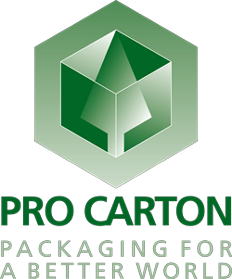International Packaging Studies‘ Review
15 June 2018
Pro Carton has compiled a review of recent international packaging studies which largely focus on four main areas of discussion - digitalisation, urbanisation, design & functionality and sustainability.
The reviews suggest that the global packaging market is continuing to grow, with several key factors driving growth. According to its ‘The Future of Folding Cartons to 2022’ report, Smithers Pira is forecasting that global demand for cartonboard used in folding carton and micro and microflute packaging applications will increase by 4.0% CAGR (Compound Annual Growth Rate), reaching a market value of $124.1 billion by 2022.
In the developing Asian and Latin American countries it is predicted that we will see a significant switch from the sale of loose goods to packaged goods. Whereas in the more developed regions, such as North America and Western Europe, packaging is expected to provide a greater consumer experience in the future.
But which products will be the growth drivers?
Euromonitor is predicting that conventional snacks will lead the packaging unit volume growth in food packaging through 2017–2021. This is being put down to the rise in snacking, but also to changes in opinions with regards to health issues around confectionery, biscuits, savoury snacks and ice cream, which are resulting in a move to smaller pack sizes and greater controls over calorie counts, whilst still maintaining and ensuring an improved customer experience.
Whilst there has only been modest growth in the Home Care packaging products sector, innovations in this market remained plentiful throughout 2011-2016, in particular for laundry care packaging.
Whilst developed countries have seen stagnant sales, developing markets, are helping to drive volume sales, which have helped to make detergent products, especially smaller pack sizes, more affordable to consumers. Smaller pack sizes will also appeal to low income consumers, whilst larger pack sizes offer value for money and will appeal to consumers with a higher disposable income, where a balance needs to be drawn between price and convenience.
Liquid paperboard packaging is also another area where significant growth is expected, with dairy products, including alternative-milk beverages, leading the market, followed by packaging for juice products.
1. Digital
The growth in internet retail sales is continuing to be driven by consumers’ desire for convenience and competitive prices. This has affected packaging demand and requirements, as we are seeing big growth in home deliveries. This is resulting in lighter weight packaging and reduced pack sizes being used for this purpose, with consumers more often selecting multipacks or smaller pack sized products, such as travel sizes and samples rather than a full-sized variant. The two growth areas of multipacks and smaller pack sizes are appealing to consumers’ demand for more affordable products, whilst the demand for lighter weight packaging, which can be achieved by moving to smaller or condensed pack types, can provide benefits to brand owners, retailers and consumers, with savings been made in terms of production costs, transportation and delivery charges. Additionally, the use of smart technologies for packaging is also playing a part, in both automation and transportation, enabling communication with smart appliances.2. Urbanisation
Metsäboard’s urbanisation study for 2018 has predicted that in the next 35 years, the annual estimated growth rate for urbanisation will be less than 1%, which may seem an insignificant figure, but when considered as the number of people, the huge significance of this apparently small growth rate becomes clear. In 2014, the world’s urbanised population was measured at 3.9 billion; by 2050, it is estimated that it will reach 6.3 billion. As a consequence, households will be smaller, both in terms of physical space and in terms of the number of occupants. Euromonitor has predicted that by 2030, urban households globally will contain an average of three inhabitants while their rural equivalents will average 4.4. The urbanised environment is also forecast to see a growing number of single-person households. Car ownership will decrease in line with this trend, which will naturally have an effect on how consumers shop. While hypermarkets outside the city centre are still growing, their growth has slowed somewhat, in favour of other alternatives. The retail setting is diversifying, and the city inhabitants can be expected to make more of their purchases from small, locally situated shops – and more frequently, as the weekly car-enabled shop is no longer a convenience nor (with declining vehicle ownership) a possibility. Larger discount chains are also becoming increasingly prevalent within city centres, again offering a more cost-effective alternative for consumers. With a shifting work and life balance, the lines between work time and free time are blurring, with individuals increasingly likely to work at home (thereby avoiding transportation altogether). Being busy around the clock means eating on the go and taking advantage of ready-made meals, which is providing another opportunity for both small shops and local retailers and, of course, this comes with its own set of very specific packaging requirements. With the ever-changing consumer shopping habits, young shoppers are increasingly tending to shop the fresh and chilled aisles and turn their backs on processed and frozen offerings.3. Design and Functionality
A survey of 2,000 U.S consumers undertaken by Westrock in 2016 found that the importance of packaging, those who said that packaging is either very or extremely important to their product satisfaction, has increased over the past two years. Meanwhile, the importance of other factors such as product quality, price, convenience and brand have remained constant or declined over the same period. The study showed that:- Packaging is just as important as the brand. The importance of packaging to product satisfaction has directionally increased over the past two years from 18% to 26%.
- Functionality features are driving consumer satisfaction. More consumers say they have purchased a product again because of the packaging’s functionality (60%) than those who say they have done so because of the packaging’s aesthetics (38%).
- Packaging has an impact on brand loyalty. Some 35% of consumers say they have switched brands because of the introduction of new packaging.
4. Sustainability
Packaging has sometimes been considered by consumers as unnecessary, and something that can be easily disposed of, but that misconception is now changing. The Packaging Digest Sustainable Packaging Study for 2017 revealed that sustainable packaging is more important than ever, with 92% of respondents agreeing with this sentiment. 89% of respondents felt that it is the job of the brand owners to educate consumers on sustainable packaging. Now in its tenth year, this annual research report provides insights into the trends, issues and concerns of the sustainable packaging community. At the same time, the study by Stora Enso found that consumers wanted to simplify the whole packaging concept. Ideally, they would like to see more:- Recyclable, biodegradable material
- Edible packaging (!)
- Packaging that disintegrates after use (!)
- Stores where you have to bring your own packaging or only get paper bags or where everything is wrapped in paper
- Functional, re-sealable packaging
- Friendly colours also for bio products




